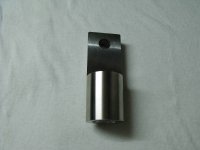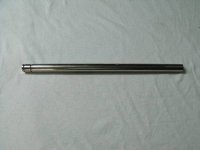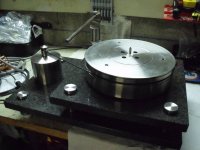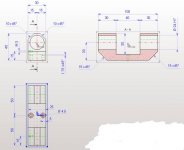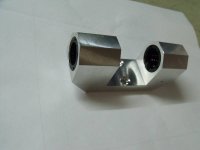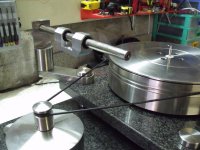THANKS Ralf,You have done a very nice job.
By the way, was the platter rotating when you listened to it?
Just kidding.
Sincerely,
Ralf
I tryed with both ears and 33 rpm and 45 rpm.
Mesurements to come soon.
Overview:
Hi!
You are industrious clever!
Excellent work!
It is waiting for completion of the project!
Sincerely, AlexПрослушать
На латинице
https://sites.google.com/site/agalkaaudio/
THANKS AlexHi!
You are industrious clever!
Excellent work!
It is waiting for completion of the project!
Sincerely, AlexПрослушать
I tryed to get a few examples on the net, but I have found different kind of tangential tonearms. Then I asked to one of the shops where we buy parts for our machines. Smaller diameter has less resistance, but less presicion too. In fact they have given me a couple of 3 kind of linear bearings (D12-D14 and D16), I have done a test and the best was D16.How did you decide on the tonearm slider rod diameter?
And I have also seen something interesting, when I put load on the bearing, the translation is smoothly better. That's why instead of doing the sliding cart with aluminium, I'll do it in stainless steel. Here is the drawing of the cart (where the linear bearings are):
Attachments
Last edited:
It's also in my plans, a short S type made with thuya burl, and a long straight one may be in carbone, I don't know yet.Will you have a facility to mount mulitple tonearms simultaneously in the future if you want to later?
SME, LINN or REGA, is the B plan if I'm not happy with one of the tonearms I'll made.LOL I was thinking an SME but I should have known!
Hello doitmyself
If the carriage starts to move at 5 degrees, that is a coefficient of friction of .087 which is way too high. An ABEC 7 instrument ball bearing has a coefficient of friction of only .004. Once you add the tone arm and its counterweight the coefficient of friction will likely go down. I agree with "dtut" that lubrication would matters worse. Did you make sure one of the ball circuits in each linear bearing is located at top dead center i.e. 12 o'clock?
Also, do you intend to use the linear bearings for the vertical motion of the tone arm?
If you can't reduce the coefficient of friction, you may have to design a new carriage, using individual instrument ball bearings.
Sincerely,
Ralf
If the carriage starts to move at 5 degrees, that is a coefficient of friction of .087 which is way too high. An ABEC 7 instrument ball bearing has a coefficient of friction of only .004. Once you add the tone arm and its counterweight the coefficient of friction will likely go down. I agree with "dtut" that lubrication would matters worse. Did you make sure one of the ball circuits in each linear bearing is located at top dead center i.e. 12 o'clock?
Also, do you intend to use the linear bearings for the vertical motion of the tone arm?
If you can't reduce the coefficient of friction, you may have to design a new carriage, using individual instrument ball bearings.
Sincerely,
Ralf
Last edited:
I do not know how much 0,087 is in gram but it may have 1,5 gram force to move, it would me perfect.If the carriage starts to move at 5 degrees, that is a coefficient of friction of .087 which is way too high. An ABEC 7 instrument ball bearing has a coefficient of friction of only .004.
Ralf
I think to make that assembly as light as possible is also a must, to let the arm follow a not perfect flat record. And to reduce friction and the forces that come with the friction. The assembly is unnecessary bulky now. Make it hollow on the bottomside is maybe a good idea.
It would also possible to reduce the construction to one linear ball bearing, instead of the two you need with this construction.
Last edited:
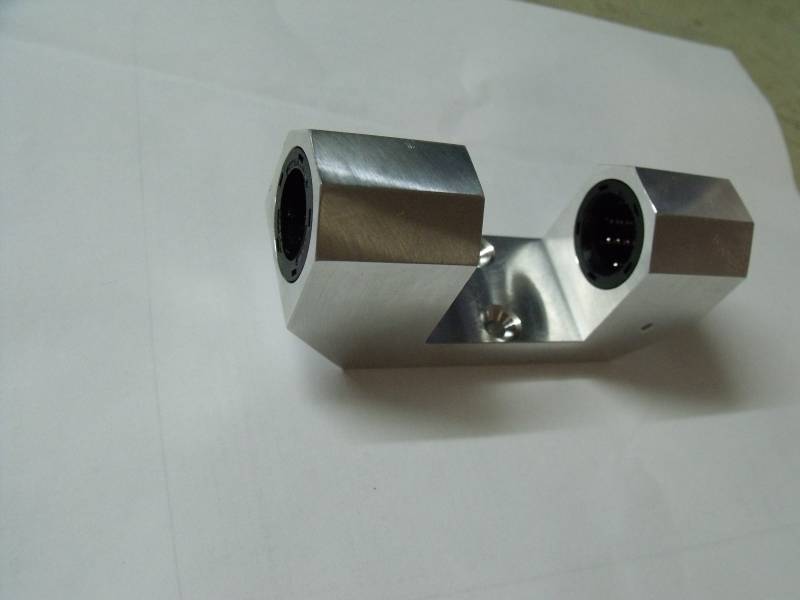
Would a light construction like this with at both ends a precision brassring as bearing slide lighter than a ball-bearing?
Or make the shape from brass. May be at one ball in the top side at both ends. By drilling from the bottom side in the inner topside of the brass bearing.
Coefficient of friction
If you have a scientific calculator, type in 5 (degrees) and press the tangent key.
Sincerely,
Ralf
.087 is the Tangent of the angle at which the carriage starts to move. And that is the coefficient of friction for that bearing and shaft combination.Helmuth;2651658]I do not know how much 0,087 is in gram
If you have a scientific calculator, type in 5 (degrees) and press the tangent key.
Sincerely,
Ralf
Last edited:
Car wax
The bearing balls would indent themselves into the car wax and impede the motion of the linear bearing.
A clean shaft and bearing balls would be best.
Sincerely,
Ralf
Helmuth;2651690] As lubrication of the axle maybe carwax is good product to make it run smooth.
The bearing balls would indent themselves into the car wax and impede the motion of the linear bearing.
A clean shaft and bearing balls would be best.
Sincerely,
Ralf
- Status
- This old topic is closed. If you want to reopen this topic, contact a moderator using the "Report Post" button.
- Home
- Source & Line
- Analogue Source
- DIY Personal Turntable
